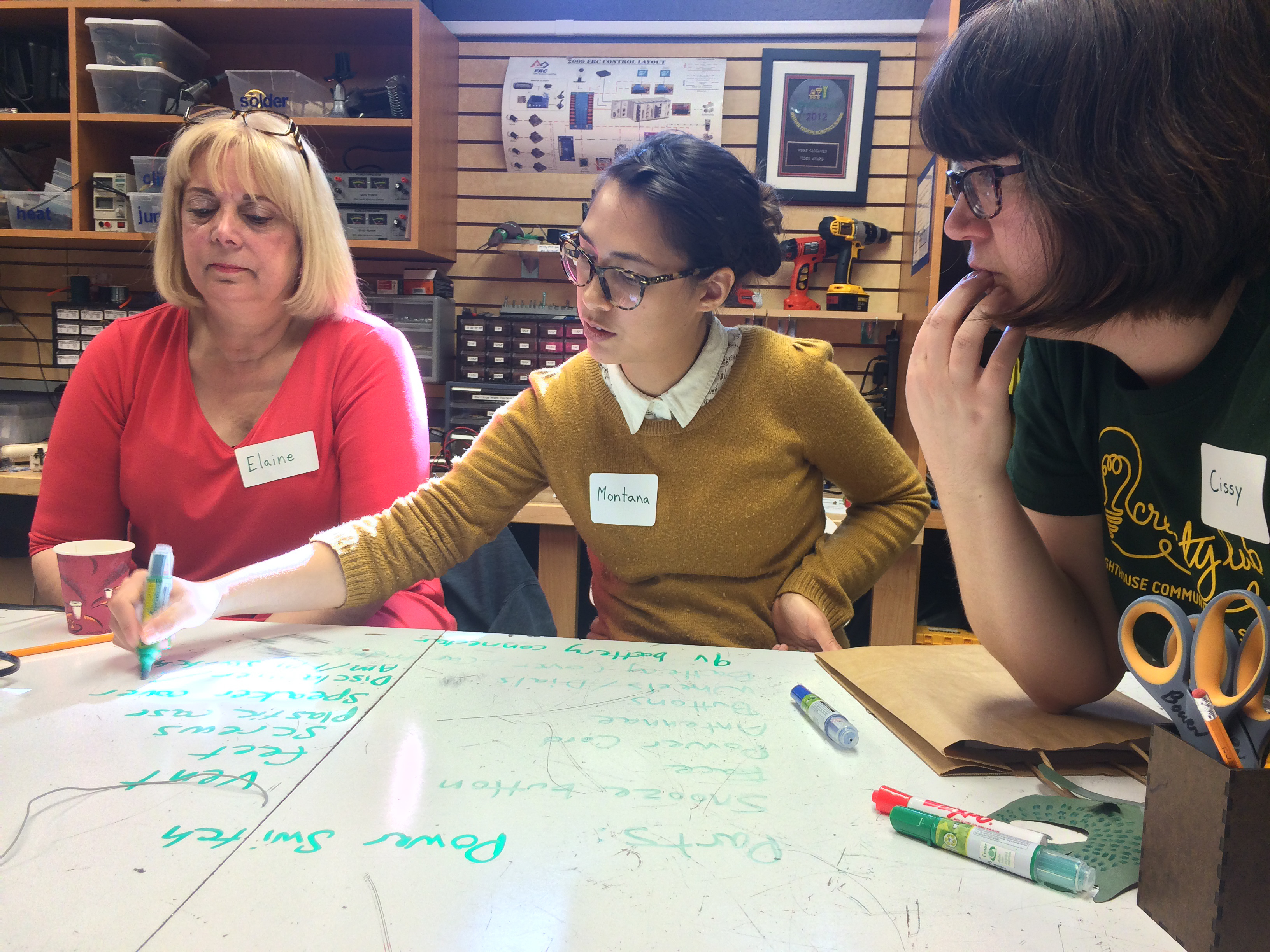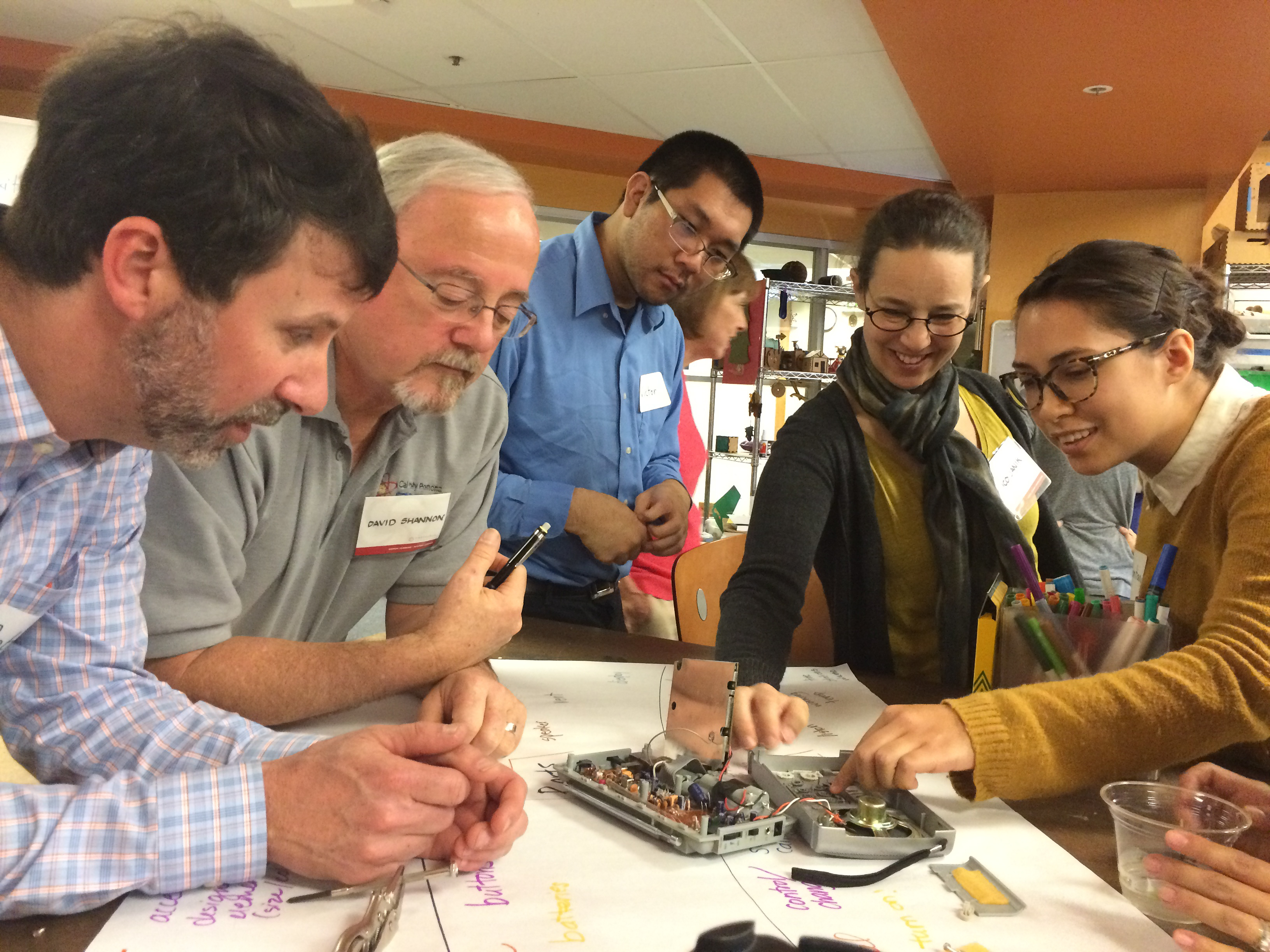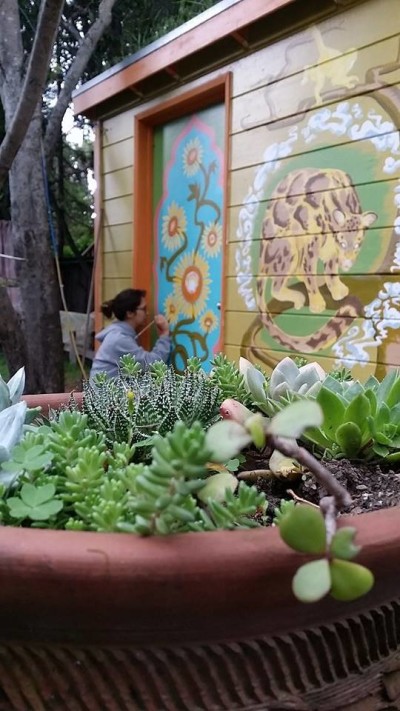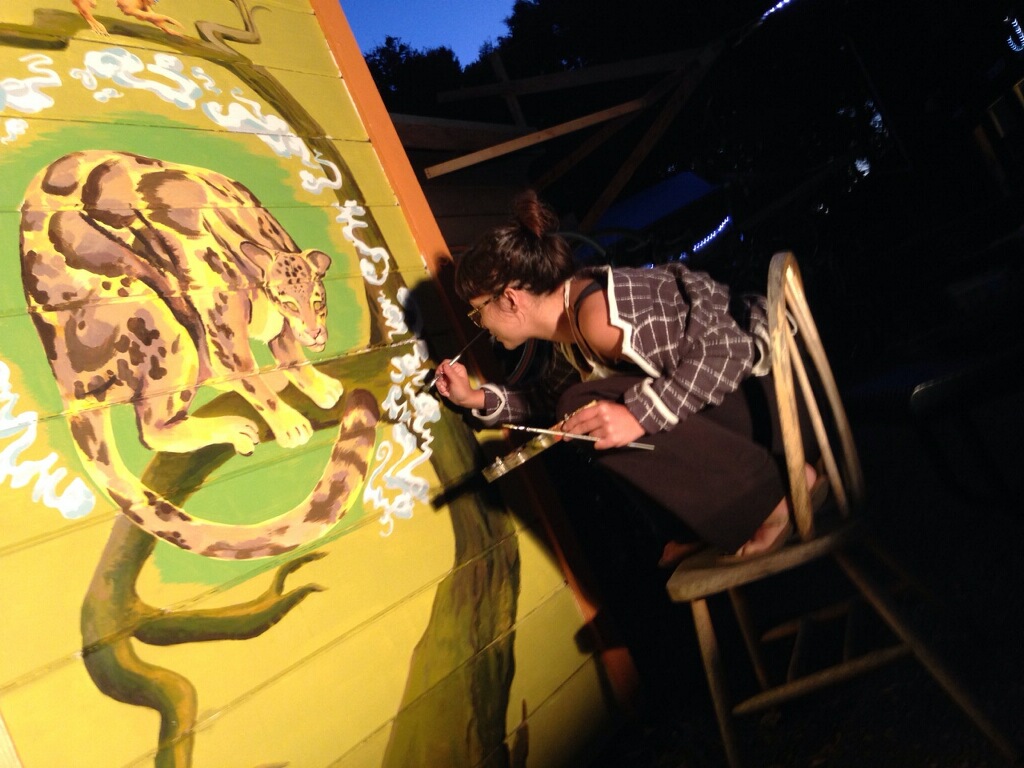
A preview of Montana’s interview that gives us a glimpse into her role as a Maker VISTA member.
This post is part of an on-going series called Beyond VISTA, where we highlight the work that our Maker VISTA members and subsite supervisors are doing within the Maker VISTA community and beyond. We focus in on their personal interests to show the wide range of perspectives and passions that the Maker VISTA community brings.
In this post, Karim Willens, Project Coordinator for the Maker VISTA project and located in the Maker Ed office, had a chance to catch up with Montana Manalo, the Maker VISTA member at Ravenswood City School District in Palo Alto, California. Karim spoke with Montana about her love of art and her role as an artist, as well as her work with the Maker VISTA project.
Maker VISTA Questions
Karim: What was your favorite grade and why?
Montana: 1st and 2nd grade really stand out to me. I had the same teacher for both of those years and she was a maker. She was really into crafting and would come up with hands-on activities for us. It was a big impact on me because I got to do all these hands-on crafts, that was a focus for my teacher and I loved it. We did paper plate animals where you take a paper plate and you cut out some construction paper shapes to make features of a face. We would do a different animal every week or every day. I also remember being really fascinated when I was learning how to read and getting very excited about letters and words and how things began to click with me.
Karim: What type of experience has the Maker VISTA Project been for you?
Montana: It has been an extremely positive experience for me. In my past employment, I’ve worked in service positions doing food service. I like to help people, but in those past positions, I felt like my ideas were not valued. So being part of Maker VISTA gives me a chance to do service for people to help with creative problem solving. Everybody on our team has a different skill set and I’m the only person who has invested a large amount of time and energy into art. I think that is really an important perspective and so I’m happy I can bring that variety to the team. Everybody is always talking about STEM but I try to replace it with the word STEAM when I have the opportunity to because you need to be an artist in order to design. An artist’s vision really helps, and a lot of the times it is difficult to get people interested in your invention if it is not cool looking from the outside.
We also received a grant from Google so we have been able to take part in more professional development. That is really exciting for me because I love learning. Once in awhile, being able to switch roles and be more of a student than a teacher helps me. It opens up a bunch of possibilities; when you have a huge resource like that, you have the possibility of implementing new curriculum and starting new programs.
Karim: What does Maker VISTA bring to the schools that you guys have been working at?
Montana: Well our schools struggle to meet expectations with standardized testing, which is stressful. The curriculum that I’m responsible for bringing to the schools is a lot more fun. We make a point of saying students learn more and retain more if they’re having fun and so it is our mission to do it. We have brought a lot of materials and equipment to the school district which is really huge. There are a lot of students in our school district that don’t have access to technology at home. They don’t get to go on family outings and go to museums and discover these things with their families so it makes a really big difference for them to be exposed to high-end technology in their own classroom or in their own schools because it makes them associate these things with something that belongs to them. They get to take ownership of technology, and if you’re raised with that then you don’t feel intimidated by it as an adult or you don’t feel like you were excluded from that movement.
Karim: How has Maker VISTA affected you in your personal growth?
Montana: I was not as confident in myself as an organizer or a leader before being in this role. I have always felt the need to voice my opinion when I felt something was not fair. I get to recognize problems and articulate what is wrong about it and come up with creative solutions. I have learned a lot about myself that way. I’ve also learned more about my own strength as a communicator. There are a lot of situations where I need to be able to read somebody who isn’t necessarily voicing their concerns verbally so I knew before that I had a knack for reading body language and listening to people.
Karim: What do you love about Maker VISTA?
Montana: What I love about Maker VISTA is the way that I’m constantly challenged. Improvisation is a big part of this role. You’re constantly given new challenges and you are trying to find solutions which involve all of these team members. It is like a puzzle. The more creative and playful you can be with your solutions, the bigger the reward is. I get to experiment with different hands-on activities, such as crafts and equipment, most days of the week in the classroom and with my team as part of professional development. I love that it brings out a lot of inspiration and optimism in people. Since we’re all talking about children and the future possibilities, it expands your mind. I appreciate that it brings out this whimsical side in people because you are trying to come up with creative fun activities on a daily basis.
Karim: How do you feel about the team you are working with?
Montana: It’s been really exciting because my supervisor Nico Janik and I are the only women on our team with 10 people. I think in the past I would have been a little bit doubtful of my ability to fill the role of a leader in this environment. I’m really happy that I have been able to step up to that as a woman and it makes me feel that I am a strong role model.

Karim: What has it been like working so closely with kids (or at a school)?
Montana: You know children are the newest thing. People like to talk about technology and what’s the next thing and follow trends, but when you are at a school and really listening to kids talk and find out what is interesting to them, that’s what is going to be up and coming. Even though you’re just passing through to get to classrooms and you are not necessarily working with the kids, hearing kids playing and seeing them run around it gives you a lot of energy. I didn’t realize how important it was for me before. I have a couple of little siblings, and I always emphasized how important it was for me to communicate with them and be a role model for them and be available to support them emotionally. I didn’t realize I felt that way about children in general and now I see that as an important part of my life, so beyond this position, I would like to continue to keep working with children and for children.
Beyond Maker VISTA Questions
Karim: You mention that you are the artist of the team. What type of artist would you describe yourself as?
Montana: That’s something that evolves for me. I saw myself as an Illustrator for a long time. To me, the difference between a fine artist and an illustrator is that an illustrator’s goal is to communicate some specific idea or information visually. A fine artist’s goal is to just express themselves in their own identity. Being an illustrator is an inherently collaborative job or occupation to have and so I like that. I haven’t always considered myself to be a very social person at the same time. I like being able to use my hands to help other people try to communicate what their ideas are. So an artist and an illustrator are words I would use to describe myself for now but I also still see myself as a student because I’m learning a bunch of different techniques.

Karim: When was the first time that you notice your artistic talent or love for art?
Montana: I have a lot of family members, and we have always drawn together as a past-time so it’s kind of something I was born into.
Karim: How did you progress as an artist?
Montana: I’d say I’m naturally a visual thinker; things have always made more sense to me when I see it as a picture or art. As a child, I was definitely frustrated at what I saw as my inability to express myself visually so I have spent many years working really hard to develop that. I think it’s worth it whenever other people tells me “wow that would be so fun to be able to draw like you can” or be able to draw that well. I always tell them — well if you’re interested in it and you put time into it, then it’s possible and I think it is worth it so you should try to do your best. I would say I’m naturally interested and the skill set comes from a lot of time and work.
Karim: What inspired you with your artwork and kept you going?
Montana: I’m really inspired by animals. I love animals a lot, and I think that is something that has driven me to be able to communicate non-verbally through pictures. A lot of my artwork is of animals. Communicating non-verbally, I think, is really powerful if you don’t have a strong voice or if you are not an eloquent person or if you are really shy and you don’t like speaking to people. But you have a perspective and you want people to respect it, so I think trying to create something beautiful with your hands is a great way to express yourself.
Karim: When did you start taking your art talent seriously?
Montana: I would always look forward to art as an extracurricular in grade school. And then in high school, every time it was a possible class for me to choose, I would choose to participate in an art class. I was really ambitious with what I wanted. Like I said, I struggled a lot trying to express what I had in my mind, when I was still learning how to make art, so I would get really frustrated with myself. I see that as taking art seriously. When I was in group therapy sessions we were talking about our different coping skills and I also decided it was a really calming activity for me to draw and eventually I stop taking medication or having psychological issues and I just made a point of drawing every time I was stressed out as a way to alleviate stress. When I realize how helpful that was to me and how much healthier I felt dealing with my problems in an organic way, I felt really empowered.I realized that artwork was extremely important to my life, as a way to manage stress and emotions. I wanted to improve other people’s lives through the act of making artwork so I take art really seriously when I create craft activities for kids at school because I see it as something that could potentially be lifesaving or really transformative for somebody’s life. Kids are always filled with energy; they’re always being told what to know. That bottles them up, so being able to create something that is not based in reality or just doing whatever you feel like is really important for mental health so that is a reason I take art really serious.
Karim: What does art do for you or represent to you as a person?
Montana: I try to take a surreal approach to artwork have an active imagination and I believe that was powerful for me as a child. It is really exciting that someone can have an entire realm within themselves even as a child. I believe that books do the same thing for people where you’re visualizing every character and every scene and it becomes something that you can own that’s sort of a secret.I would like to inspire other people that way. I was interested in children’s books illustration because you can invent a character and make it really lifelike and interesting for a kid so that that character takes on his own life in somebody else’s imagination. I’m so interested in trying to create characters that can live on independently of me and the work that I do. Aside from that, I also like portraiture a lot. I have done portraits of the kids at the school district that I serve because it’s really a revolutionary act to create high-quality portraits of people who can’t afford to commission them. Especially if you put them up in a public place. I have also been working on a mural at my co-op. I think that murals are a great vehicle for social justice because you’re beautifying the city, you are empowering people of color if you are including them in your mural and just accessing people’s imagination is exciting to me. I see art as serving a social justice purpose in that way where you are giving somebody historical significance.
Karim: What is the most abstract piece of art you have ever seen if there is such a thing?
Montana: Yeah I don’t know man, that is a tough one. I think kid’s art is really fun and weird to look at but I think it becomes a lot more fun if you ask them about it and they explain it. A lot of the time, you just don’t understand what it is until they explain it and then they will make a little story about it.

Karim: How have you integrated your art within your role as a Maker VISTA?
Montana: Being able to express yourself creatively is important for mental health. It’s not something that I talk about at work because I think that people see that as being controversial, like I’m pushing my own agenda. It is what motivates me to introduce craft activities into every school in the district. It just obviously makes the kids happy, and a lot of techniques that I use in school have ended up being helpful here, especially the cardboard crafting. The practice of making art teaches me some really valuable lessons and skills like improvisation, because in a way, there is sort of an art to being a facilitator at a makerspace. You show up, the tinkerer has got a couple activities laid out or maybe they don’t have anything out and you have to just be able to work with what you got. You are crafting an experience instead of crafting something visual. It also helps me recognize students who are interested in that and students who have a strength in that. The critiques I have done in school have helped me find the right language to talk to students about the work that they are doing. That makes me happy. It makes me feel my experience is benefiting the kids because they are seeing something that they made mean something, instead of an activity just being a pastime.
Karim: What is next for you with Maker VISTA?
Montana: With Maker VISTA, I’m trying to work harder on curriculum integration — it’s one of the last things that I am working on in my service term. I see it as the highest priority now that I have been a part of this program for a really long time, so I’m giving out all these curriculum maps for all of the different subjects. Next for me after my service term is over is I would like to go back to school. I applied to a couple of different art schools and I heard back from California College of the Arts so I would potentially be staying in the Bay Area. It has also been really disorienting to have this position here because it makes me value working with children so much, and that is kind of off-base from where I saw my career goals. I don’t know if I would be interested in looking at an art teacher role, for example, at Lighthouse Community Charter School. It’s really a maker-focused job so it seems like it would be a really cool fit. But at the same time, I don’t really know if that is going to be aligned with my other goals of developing my own work as an artist.

Leave a Reply